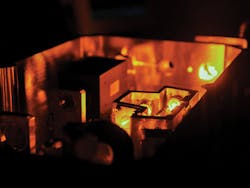Sodium guide star at Larmor frequency extends geomagnetic studies
Geomagnetic field measurements on the meter scale can locate buried ferromagnetic objects, on the kilometer scale can identify geological formations like mineral or oil deposits, and on the largest scale (hundreds of kilometers) can yield information on Earth’s outer mantle and ocean-circulation behaviors critical to climate-change models. To avoid local perturbations, 100-km-scale measurements require remote analysis at 100 km altitudes. Sodium guide-star lasers, pulsed at the magnetic precession frequency, or Larmor frequency, can significantly enhance backscattering from the sodium layer and can be used for remote magnetometer studies with mesospheric sodium.
For the first time, researchers at the Shanghai Institute of Optics and Fine Mechanics (SIOM; Shanghai, China) have succeeded in developing a high-power 589 nm sodium laser pulsed at the Larmor frequency in the 200–350 kHz range for remote magnetometry, which translates to analysis of 100-km-scale variations at the ground. Although technically challenging to develop because of the combined requirements on power, linewidth, and repetition rate, SIOM researchers used frequency doubling of a high-repetition-rate pulse-pumped 1178 nm single-frequency Raman fiber amplifier. A 589 nm laser with 17 W average power was demonstrated at a duty cycle of 20% and a repetition rate of 350 kHz, which is suitable for a geomagnetic field of 0.5 G. The pulse-repetition rate and duty cycle can be adjusted easily for use in different geographic locations and for remote geomagnetic analysis at distances of 100 km. Reference: X. Yang et al., Opt. Lett., 42, 21, 4351–4354 (Nov. 1, 2017).
About the Author

Gail Overton
Senior Editor (2004-2020)
Gail has more than 30 years of engineering, marketing, product management, and editorial experience in the photonics and optical communications industry. Before joining the staff at Laser Focus World in 2004, she held many product management and product marketing roles in the fiber-optics industry, most notably at Hughes (El Segundo, CA), GTE Labs (Waltham, MA), Corning (Corning, NY), Photon Kinetics (Beaverton, OR), and Newport Corporation (Irvine, CA). During her marketing career, Gail published articles in WDM Solutions and Sensors magazine and traveled internationally to conduct product and sales training. Gail received her BS degree in physics, with an emphasis in optics, from San Diego State University in San Diego, CA in May 1986.
